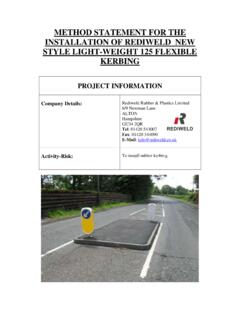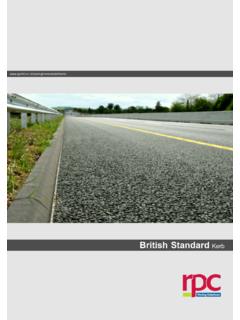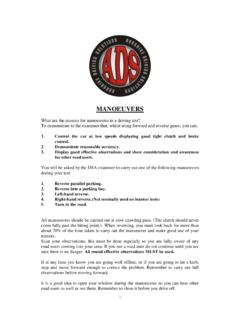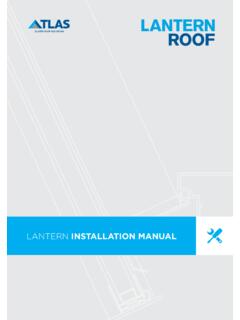Transcription of METHOD STATEMENT FOR THE INSTALLATION …
1 METHOD STATEMENT FOR THE INSTALLATION OF REDIWELD HARLOW KERB PROJECT INFORMATION Company Details: Rediweld Rubber & Plastics Limited 6/9 Newman Lane ALTON Hampshire GU34 2QR Tel: 01420 543007 Fax: 01420 544090 E-Mail: Activity-Risk: To install rubber kerbing. IMPLEMENTATION & CONTROL OF RISK Hazardous Task Risk METHOD of Control 1. Put out warning signs and sufficient traffic management measures to ensure the safety of operatives, road users and pedestrians. Risk to operatives and third parties will be high. 2. Mark road, were kerbing is to be positioned. Loose lay kerbs, Make sure units are in position required and butted up tightly, then using a 14mm drill bit for tarmac construction or 10mm drill bit for a concrete construction drill through unit to a depth of 100mm for tarmac or 120mm for concrete.
2 The drill used will be a Hilti T15 or T21 hammer drill (or similar) attached to a 3 kva generator via a 25 m. 110 v extension lead. Risk to operatives will be medium. Risk to third parties will be low. 3. Blow out fixing holes using a long nosed air gun, powered by a 120psi portable compressor. Risk to operatives will be medium. Risk to third parties will be low. Operatives will follow the correct procedure for accessing the site. Works vehicles will be safely positioned with amber beacons on. Warning signs and traffic management measures will be positioned, as per Chapter 8. The site will be clearly defined and barriered.
3 Safety zones will be maintained at all times. Signs will be adequately placed and sandbagged if necessary. If two-way lights are to be used, cables will be run along edges and channel strips will be used. A safe, signed pedestrian route will be provided and maintained at all times. Reversing operations will be minimised. Operatives will have adequate training in manual handling and will employ handling techniques to lift individual rubber units at all times. Operatives will wear gloves and safety boots, at all times to prevent trapped fingers and damaged feet. A first aid box will be provided on site at all times.
4 Operatives will only work within the site working space to protect both third parties. Plans of services will be obtained prior to commencing work on site. A visual survey of the area and a CAT scan will be carried out prior to drilling. Operatives will wear appropriate eye, ear and feet protection. Dust masks will be worn, if necessary. Regular checks will be made on the condition of airlines and the tightness of fittings. Hoses will be run safely and will avoid pedestrian routes. To prevent vibration white finger, reduced vibration equipment will be used, 4. For tarmac insert nylon plug, coach-screw and washer tap down assembly and tighten with impact wrench, ensuring washer is firmly seated.
5 (Do not over-tighten). Repeat until all units are secure. For concrete insert through bolt assembly tap down and tighten with socket wrench (Do not use impact wrench), ensure washer is firmly seated. Risk to operatives will be low. Risk to third parties will be low. all units are secure, infilling can be carried out using material specified all work debris & personal rubbish from site. Risk to operatives will be medium. Risk to third parties will be low. traffic management signs and barriers. Risk to operatives and third parties will be high. regular job rotation will be implemented and operatives hands will be kept as warm as possible.
6 Fuel for generators will be stored in suitable containers in a secure area. Caps will be kept on fuel containers and refuelling will not take place near storm drains or watercourses. Spill kits and a fire extinguisher will be available on site at all times. (Refer to COSHH sheets for petrol). Operatives will wear appropriate gloves, goggles, masks and long sleeves. Operatives will only use the air gun within the site working space to protect third parties. Resin containers will be stored in a secure area, with caps on to prevent spillage / water contamination. (Refer to COSHH sheets for resin).
7 Safety measures relating to the generator, portable compressor and hoses will apply as outlined in section 3. As outlined earlier. Operatives will have good hygiene standards, use gloves (where practical), clean and cover cuts and will carry a Leptospirosis card. Operatives will comply with the sequence of removing signs as per Chapter 8 when dismantling traffic management measures.






